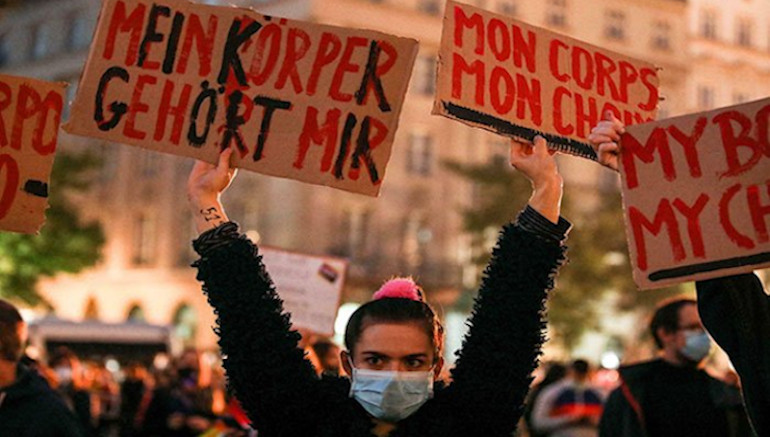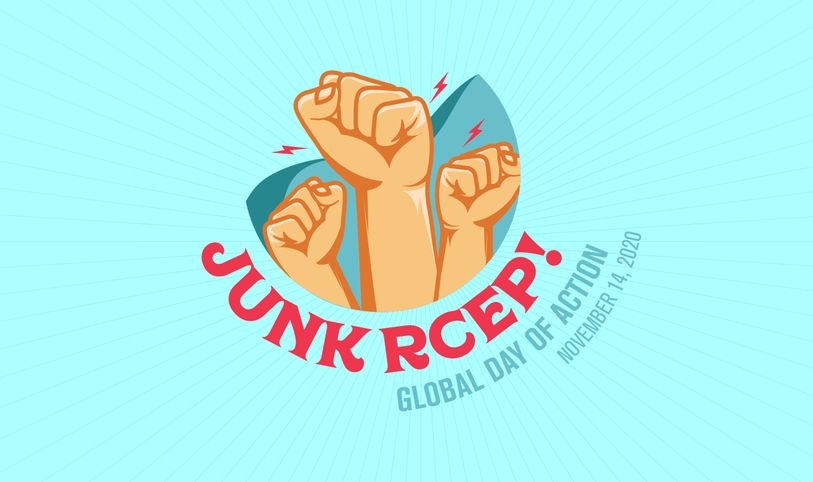Ditch the patents, Nationalize Big Pharma
Canadians have understandably been concerned first and foremost with fighting the virus in their own backyard. But COVID is a worldwide threat and there won’t be a real victory, or real safety, until it’s won around the world. Vaccination in Canada has been moving along at a steady pace while nations with 80 percent of the world’s population have so far had access to less than a third of vaccine doses, and on current trends it’s expected to take two years before they’re fully inoculated. This so-called “herd immunity” might be achieved in Canada over the next six months but it will be to no avail if the countries of Africa, Asia and Latin America become virus incubators capable of “exporting” the latest mutations back to the developed world. And on that front the latest news is bad and getting worse. India, with the world’s second biggest population, is suffering the worst, where a new and even more dangerous “double mutant” variant of the disease is sickening hundreds of thousands of people a day. It’s a deadly threat in that country, but it’s a threat to Canada as well. Cases of the double mutant strain are already showing up in this country, which prompted Ottawa to suspend passenger flights from India and Pakistan.
India – mass producer of vaccines
It will come as a surprise to many people that India is home to the world’s biggest vaccine manufacturer, the Serum Institute of India. The company says two-thirds of all children in the world get its vaccines. They specialize in generic versions at low profit margins and export to 170 different countries. They were also making, under licence, the AstraZeneca and Novavax vaccines. At its peak in early April, India was administering a record high of 3.5 million COVID shots a day on average. But this number has consistently shrunk since, reaching an average of 1.3 million shots a day by the week of May 3-10. One reason for the drop in shots is that there are just not enough available, experts say.
In the early phase of the vaccine rollout, India was actually exporting AstraZeneca to poorer countries. Those exports have been cut drastically as India tries to “look after its own.” The Serum Institute is racing to keep up with orders from the Indian states, but its production facilities currently can produce only 60 to 70 million COVID doses a month. The Indian government has created a hell in India with Prime Minister Modi holding mass political rallies and not cancelling the huge religious ceremony of Kumbh Mela, while COVID cases were soaring. Now hospitals have run out beds, oxygen and medicines. There is a wood shortage for cremating the dead. The TV news shows images of patients dying of asphyxiation in hospitals whose medical oxygen supply has run out and of mountains of corpses waiting for cremation or burial. India’s health system has largely been privatized. Modi’s reactionary and pro-capitalist policies have created a nightmare.
Petitioning the WTO – don’t trip
So, what to do? The system of granting patents to pharmaceutical companies has been identified as a major issue. It is indeed a problem but is only one part of the greater problem; the other is technological know-how regarding a drug’s formulation and manufacture – in other words, capitalist control of manufacturing and distribution. The first is protected under the WTO’s Trade-Related Aspects of Intellectual Property (TRIPS) agreement, which grants patent monopolies for at least 20 years. The second is closely guarded by pharmaceutical companies. Together, they have the effect of transferring ownership of what could be a public good (combating a global emergency) to the private hands of a privileged few.
In October 2020, India and South Africa, since joined by another 100 countries, petitioned the WTO to temporarily waive patent rights – a provision that the TRIPS agreement permits in “exceptional circumstances.” If a global pandemic does not constitute an “exceptional circumstance,” what does? Yet, this petition was immediately opposed by Canada, the United States, the European Union, Britain, Norway, Switzerland, Japan and Australia, as well as – of note – Brazil. The logic was that waiving patents will set a dangerous precedent, inhibiting future innovation. On the contrary, it would break the monopoly over vaccine production held by the likes of Pfizer and open the door to turning out a lot more doses at cheaper prices. The argument against waiving patent rights ignores the fact that drug companies have already earned billions in profits from current vaccines, some of which were directly developed using taxpayer money and all of which were built on the foundation of publicly financed research in national research institutes and universities.
Mariana Mazzucato, Jayati Ghosh and Els Torreele, part of the People’s Vaccine Alliance, pointed out in The Economist that the US government alone invested some $12 billion US in vaccine research and development and estimated that 97 percent of the cost of developing the AstraZeneca/Oxford vaccine was publicly funded. “Already today, the main vaccine-producers received what could be considered reasonable returns on their investment and more. For example, the estimated sales of the Pfizer-BioNTech vaccine in 2021 is $15bn with a profit margin as a percentage of revenue in the high 20s, according to Pfizer.” Neglected diseases (like Ebola) get hardly any of the share of R&D funding. They’re placed in the category “neglected” but really, they should be called “unprofitable” because these illnesses primarily grip people in developing countries and rely on investment from the public sector, which funds only a small fraction of total health R&D compared to industry. More money goes into fighting baldness and erectile dysfunction than hemorrhagic fevers like dengue or Ebola.
Some good news has come with the Biden administration throwing its weight behind support for the TRIPS waiver. We should note that Biden’s decision didn’t come out of the blue. There had been a movement on the ground with socialist city councillor Kshama Sawant playing a key role in getting her council in Seattle to pass the first-in-nation resolution calling for the US to support the suspension of the relevant TRIPS clause. Many other cities followed suit. The bad news is that countries like Germany and Canada still remain opposed. “We are of course continuing to work at the WTO on a range of discussions around proposals and we look forward to moving forward on a consensus basis,” said Trudeau in his usual wishy-washy way!
The story of patents
What is a patent? Essentially, it’s a government authority or license conferring a right or title for a set period, especially the sole right to exclude others from making, using or selling an invention. In other words, it’s a government sanctioned monopoly. It is remarkable that mainstream economists, who usually view themselves as advocates of free market transactions, unquestioningly embrace patents or other forms of intellectual property rights. They have their origins in the feudal guild system, not the free market economics of Adam Smith. In fact, at the end of the 19th century, Switzerland and the Netherlands actually eliminated patent and copyright protection, with the intent of promoting free market competition. In spite of their feudal legacy, and their obvious status as forms of protectionism, few economists ever question the merits of the patent system.
The basic argument for patents and copyrights is straightforward. You get rewarded for your time and effort in the research process by protection for a pre-determined period, allowing you to keep competitors at bay. It follows then that in a free market, without protections for intellectual property, there will be under-investment in research. As soon as an innovation is made public, others could duplicate the process and sell a comparable product, without having to bear the costs of the research that allowed for the innovation. However, the fact that a free market will under-invest in research is a damning condemnation of capitalism and hardly establishes that the feudal institutions of patents are the most efficient way to support innovation in the 21st century.
Most capitalist economists argue against the inefficiency of various forms of trade protectionism (principally, tariffs and quotas). The argument is that protectionism causes excessive increases in prices. This is true, but while tariffs and quotas rarely raise the price of goods by more than 30 or 40 percent, patents on prescription drugs typically raise the price of protected products by 300 to 400 percent, or more. In some cases, patent protected drugs sell for hundreds or thousands of times as much as the competitive market price. In 2010, the US spent $210 billion on prescription drugs. In the absence of patent protection, the same drugs would have probably cost no more than $50 billion. (The savings would be equal to $500 per person).
Patent exceptions – the wheel, insulin and polio
The invention of the wheel has been traced back to ancient Mesopotamia around 4,000 BCE. We don’t know the name of the individual(s) who invented it but it’s safe to say that no patent was taken out and little money was made. Obviously, innovation doesn’t depend on a cash reward. Not everybody who has made a breakthrough in the field of medicine/vaccines has felt compelled to make a profit through their inventions. In the modern era, Canadians Frederick Banting and Charles Best developed insulin, a treatment for diabetes, in 1922. They “sold” the patent to the University of Toronto for one dollar – Banting said, “Insulin belongs to the world, not to me.” Furthermore, as production ramped up, the insulin plant was producing 250,000 units per week. Increased capacity and improved methods resulted in its price falling by more than 50 percent (from five cents to two cents per unit) in a matter of a few months. Can you imagine Pfizer and Moderna voluntarily reducing the price of their vaccines as capacity increases? Another case was the American, Jonah Salk, who, in 1955, discovered the vaccine for polio which he didn’t patent. When asked about it, he replied “could you patent the sun?” Had it been patented, it was calculated to be worth $7 billion. The quest to make improvements to life, the desire to help humanity and the natural tendency to satisfy our curiosity are better explanations of new inventions and discoveries rather than some so-called innate “entrepreneurial spirit” or a compulsion to make a buck out of anything – ideas beloved of capitalist apologists.
Compulsory licensing
Although patents have a long history, the system enabling a company that holds the patent on a drug to monopolize its production, even in a global emergency, is a recent development. During the second world war, the US government forced pharmaceutical companies to share recipes for antibiotics. In the worldwide campaign against smallpox, the WHO maintained a register of manufacturing techniques and recipes, evaluating them and helping to share the technology globally. There was a recognition that some things are more important than the legal protection of profit. In that regard, there already exists in Canada a way around for the government to override patent rights. It’s called compulsory licensing and consists of a law, on the books since 1923, that allows the government to override the monopoly patent rights of drug manufacturers in times of public health emergencies. As Thomas Walkom explained in an article in the Toronto Star, “Compulsory licensing has a long history in Canada. In 1969, Pierre Trudeau’s Liberal government used it to allow the production of cheaper generic copies of vital brand-name drugs. The results were spectacular. From 1969 until 1987, Canada enjoyed some of the lowest drug prices in the world.” Naturally, Big Pharma was none too happy with this situation. Walkom explains, “But the brand-name firms hated compulsory licensing. It ate into their monopoly profits. They threatened to kill their drug manufacturing operations in Ontario and Quebec unless Ottawa relented. In 1987, Brian Mulroney’s federal government responded to the pressure by limiting compulsory licensing. The brand-name giants praised him. But over time they cut back their Canadian manufacturing operations anyway.”
Vaccine patents end at the border
But compulsory licensing doesn’t solve the COVID vaccine access problem for poorer countries. The same issue arose in the context of access to HIV medications during the late 1990s.Just as with HIV drugs then, the capacity to manufacture vaccines today is unevenly distributed. The real issue isn’t whether a country like Botswana can issue a compulsory license allowing its domestic companies to manufacture the vaccines – many countries don’t have that kind of production facility and, in many cases, the drugs aren’t even patented there. The real issue is whether India or China or the Philippines – countries with thriving pharmaceutical industries and where drugs are much more likely to be patented – can issue a compulsory license that would allow their companies to export to Botswana.
Article 31 of the WTO’s Agreement of Trade-Related Aspects of Intellectual Property, or TRIPS, limits compulsory licenses primarily to domestic production and use. It does not allow a country to issue a compulsory license to a company outside its territory. Countries also cannot issue compulsory licenses to companies within their territories to produce products primarily for export. For COVID, there is also another problem: the technologies in COVID vaccines are complex and involve multiple patents, trade secrets and know-how. A compulsory licensing system would need to address not just patents on the drug itself but all related intellectual property.
We would not deny that drug research requires funding but when you break down Big Pharma’s spending, the part of the pie devoted to research and development (R&D) loses out consistently to the part for marketing and sales. In addition, every company’s spending on R&D has increased only incrementally year by year whereas each mega drug company has seen a vast increase in revenue. And of course, what builds that revenue is the pursuit of so called “blockbuster drugs” – those that generate at least $1 billion of revenue per year for the companies that produce them.
The following sentence is taken from a company website that analyses the pharmaceutical industry. “The market for gene and cell therapies could double to $2 billion by 2024, but as these therapies cure patients, profit pools may start to shrink.” They don’t want to produce medicines that cure, they prefer medicines that manage the illness, medicines that require repeat prescriptions. The slogan of people before profits has never been more relevant.
AIDS and patents
More than 95 percent of all HIV-infected people live in the developing world, which has likewise experienced 95 percent of all deaths to date from AIDS. Many in the west are under the impression that AIDS has been conquered or is no longer a death sentence. Yet, despite the huge progress made, 1.7 million people acquired HIV last year and 770,000 died of AIDS-related illness. In developed countries, the introduction of highly active antiretroviral treatment and the availability of drugs for opportunistic infections led to a substantial reduction in AIDS mortality. In developing countries, however, access to these drugs was seriously lacking, one of the main factors being affordability. Patenting of medicines has increased considerably since 2005. More worrying is the trend of “evergreening” patents. Evergreening is a tactic used by pharmaceutical companies to extend their exclusivity over a medicine by applying for, and usually getting, multiple, overlapping patents on a single medicine. Most medicines are covered by several patents, known as patent “thickets” and are used to delay or complicate generic production.
Prices for HIV treatment can vary from under $100 to tens of thousands of dollars per person per year (pppy) for the same drug. Take dolutegravir (DTG) for example. In July 2019, the World Health Organization (WHO) recommended all countries immediately adopt DTG-based regimens as the preferred first-line treatment for HIV. Prices pppy range from $75 for countries that are in a “voluntary license,” where generic manufacturers were allowed to produce and sell low-cost versions of DTG in all low and lower-middle income countries, and across sub-Saharan Africa. If the country is not in a voluntary licence, the price is up to $9,656!
The sins of Big Pharma go beyond the patent scam. It is quite possible that Trudeau’s beloved consensus for a temporary suspension of COVID patent rights will be achieved. This would represent a small victory. However, that band aid solution is not enough. On a global basis, we need a permanent solution that addresses the COVID situation, provides resources for the problem of neglected diseases and removes the presence of Big Pharma from our health care system.
Socialist Alternative calls for:
- An end to the patent system.
- Nationalization of the big pharmaceutical companies.
- Nationalization of ancillary services such as medical laboratory services and retail pharma chains.
- Production and distribution of medicines to be co-ordinated and integrated.
- Research and development of new drugs to be planned and integrated with academic research institutions. No more wasteful duplication.




